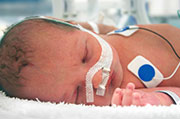- Understanding the Connection Between Anxiety and Depression
- How Daily Prunes Can Influence Cholesterol and Inflammation
- When to Take B12 for Better Absorption and Energy
- Epsom Salts: Health Benefits and Uses
- See What Saffron Can Do for Sleep and Heart Health
- 6 Common Mistakes to Avoid Before Your Physical
- Can Sweating Really Help You Beat a Cold?
- Strengthening Your Relationship: Practical Strategies
- Skip Storing This Everyday Product in the Fridge Door
- Green Tea + B3 Pairing May Boost Brain Health
More Extreme Preemies Are Surviving, Study Finds


More extremely premature U.S. infants — those born after only 22 to 28 weeks of gestation — are surviving, a new study finds.
From 2000 to 2011, deaths among these infants from breathing complications, underdevelopment, infections and nervous system problems all declined. However, deaths from necrotizing enterocolitis, which is the deterioration of intestinal tissue, increased.
And despite the progress that’s been made, one in four extremely premature infants still don’t survive to leave the hospital, the researchers found.
“Although our study demonstrates that overall survival has improved in recent years among extremely premature infants, death still remains very high among this population,” said lead author Dr. Ravi Mangal Patel, an assistant professor of pediatrics at Emory University School of Medicine in Atlanta.
“Our findings underscore the continued need to identify and implement strategies to reduce potentially lethal complications of prematurity. Ultimately, strategies to reduce extremely preterm births are needed to make a significant impact on infant mortality,” he said.
Patel said the study also found that the causes of death vary substantially, depending on how many weeks early an infant is born and how many days after birth the child survives.
“We feel this information can be useful for clinicians as they care for extremely premature infants and counsel their families,” he said.
Patel added that infants who survive often suffer from long-term mental development problems.
“Long-term mental developmental impairment is a significant concern among extremely premature infants. Whether the improvements in survival we found in our study were offset by changes in long-term mental developmental impairment among survivors is something that investigators are currently evaluating,” he said.
“However, the spectrum of mental development impairment is quite variable and families often are willing to accept some mental developmental impairment if this means that their infant will survive to go home,” Patel said.
The report was published Jan. 22 in the New England Journal of Medicine.
Dr. Edward McCabe, medical director of the March of Dimes, said that although the survival rate of premature infants is increasing, the goal of any pregnancy should be to deliver the baby at 38 to 42 weeks of gestation.
“The later these babies are born, the better they will do,” he said. “When the health of the baby or mom is not at risk, the best incubator that has been developed is the mother’s womb,” he said.
For the study, Patel’s team analyzed data from more than 6,000 deaths among more than 22,000 live births with gestational ages of 22 to 28 weeks. The births occurred between 2000 and 2011.
The babies were followed from birth for 120 days, or until they died, left the hospital or were transferred to another hospital. Infants hospitalized for more than 120 days were evaluated until they died or until they turned 1 year, according to the study.
During the study period, the death rate for extremely premature infants dropped by nearly 10 percent. By 2008 to 2011, the death rate was about 26 percent, the study found.
Overall, 40 percent of the deaths happened within 12 hours after birth. Another 17 percent happened after 28 days. The largest declines in deaths were in those born at 23 or 24 weeks of gestation, the researchers found.
The decrease in deaths from breathing complications made up 53 percent of the overall reduction in deaths. Deaths from infections, nervous system problems and developmental delays also dropped. But deaths from necrotizing enterocolitis increased and those deaths offset the overall decrease in deaths by 26 percent, according to researchers.
Deaths within the first 12 hours after birth were mostly from immature development of body systems. Deaths after 12 hours were mostly from respiratory distress syndrome, Patel’s group found.
Deaths from 15 to 60 days after birth were largely due to necrotizing enterocolitis, and deaths after 60 days were mostly from a lung condition called bronchopulmonary dysplasia, the researchers said.
The extremely premature infants who died were, on average, two weeks younger in gestational age than surviving infants. Moreover, mothers whose babies died were less likely to have had steroid hormone therapy given to prevent premature birth, the study noted.
Some of the factors related to the lower death rate for extremely premature infants included more women getting prenatal care, the wider use of steroid hormone therapy and an increase in cesarean sections, according to the study.
The increase in deaths from necrotizing enterocolitis may be due to the survival of infants who would otherwise have died before the condition occurred, Patel’s team said.
More information
For more information on premature births, visit the March of Dimes.
Source: HealthDay
Copyright © 2026 HealthDay. All rights reserved.










